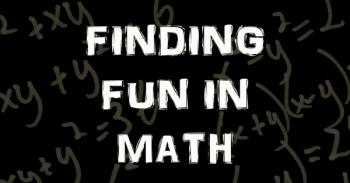Ask Professor Puzzler
Do you have a question you would like to ask Professor Puzzler? Click here to ask your question!
After school one day last week, one of my students wanted a little help with some problems she was working on. One of the problems was a system of two equations in two unknowns:
x2 + xy = 30
xy + y2 = 6

I said to her, "I like problems like this. I don't know right off the top of my head the best way to start it, and that means it's an interesting problem!" I asked her what she had tried.
She said, "I multiplied the second equation by -1, and then I added it to the first equation, to get rid of the xy term."
x2 + xy = 30
-xy - y2 = -6
------------------
x2 - y2 = 24
"That's good," I said. "So what next?"
"I don't know," she said, "that didn't seem to get me anywhere."
I said, "Okay, well, let's leave that there; we may want it later." So I put a box around it, to make sure I wouldn't erase it from the board. "Did you try anything else?"
"I couldn't think of anything else to try."
"Did you try adding the equations?"
"But nothing will cancel if I do that..."
"Try it anyway. I think something interesting will happen. I'm not sure it'll be USEFUL, but it'll at least be interesting," I said.
We did the equation addition:
x2 + xy = 30
xy + y2 = 6
------------------
x2 + 2xy + y2 = 36
It didn't take her long to notice that the left side could be factored:
(x + y)2 = 36
"And what does that tell us?" I asked.
"x plus y is either 6 or -6."
"That's great," I said, "you've just turned this into two problems!" So I drew a chart showing the two choices:
Choice One: x + y = 6
Choice Two: x + y = -6
"Now, I said," let's go back to your first equation that you came up with. Can you think of anything you can do with it?"
She realized she could factor the left hand side:
x2 - y2 = 24 ⇒ (x - y)(x + y) = 24
At this point she was getting a little excited about the problem, because it was starting to fall apart quite nicely. After all, if x + y = 6, then (x - y)(x + y) = 24 is equivalent to (x - y)(6) = 24, or x - y = 4. Similarly, if x + y = -6, then (x - y)(-6) = 24, or x - y = -4.
Now we find that we have two systems of equations:
Choice One: x + y = 6 and x - y = 4
Choice Two: x + y = -6 and x - y = -4
Both of these systems can be quickly solved (my student did them both in her head), to obtain the solutions (5, 1) and (-5, -1).
And the best part of my teaching day was hearing these words: "That was FUN!"
Then I showed her how the Teacher's Manual suggested doing the problem. Solve one of the equations for a variable:
x = (6 - y2)/y, and then substitute that into the second equation. I showed her the full solution. It was UGLY.
"I like our method better! Ours was fun!"
I understand the reasons for teaching the method that's in the text book; it's straightforward (even though it's ugly), and will work on a variety of problems. In addition, using that method gives students practice on a few different topics such as fractions and squaring binomials, etc.
We had no guarantee, when we first started the problem, that our ideas of subtracting and adding the equations were going to get us anywhere useful. As I said to the student, "We might try a bunch of things before we find something that works, but sooner or later we'll hopefully stumble on something useful."
But that's what problem solving is. Problem solving is not just using a rote method that a textbook shows you. It's looking at a problem and not knowing where to go, but being willing to try things to see what will happen. It's adding two equations together because you notice that adding them creates a perfect square, and that might be useful. It's subtracting two equations because you notice that it eliminates an xy, and that might be useful too.
It's a labyrinth of possibilities, with no guarantee that the things you try will be useful, but with the hope that somewhere there's a path that leads to a solution.
And, in the end, it's the delight of watching a system of quadratic equations disintegrate into pieces that you can solve in your head. It's the spark of excitement when the solution starts to dawn in a student's mind.
And it can be FUN!

